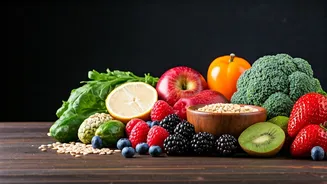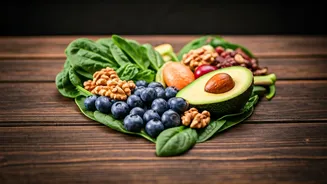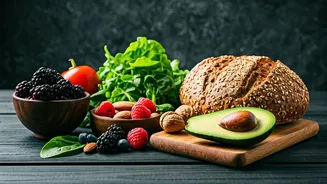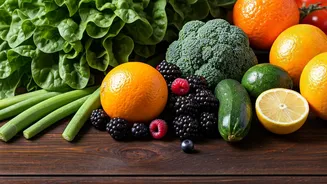Embrace Fiber Power
Fiber, particularly soluble fiber, is a slow-digesting carbohydrate, and it is a nutritional superstar when it comes to blood sugar management. Soluble
fiber slows down the absorption of sugar, thus preventing the rapid spikes often associated with high-carbohydrate meals. Food sources like oats, apples, and beans are rich in soluble fiber. Incorporating these foods into your meals can contribute to more stable blood sugar levels. Fiber helps regulate digestion and is important for preventing insulin resistance. Moreover, it plays a vital role in promoting satiety, potentially aiding in weight management. This is another benefit, as excess weight can worsen insulin resistance, making blood sugar control more challenging. Therefore, start by making simple switches, like opting for oatmeal for breakfast and including a side of beans with your dinner to experience the benefits of fiber in your diet.
Cinnamon’s Sweet Secret
Cinnamon, that aromatic spice often associated with warmth and comfort, is also a powerful ally in blood sugar management. Studies have shown that cinnamon can improve insulin sensitivity, which allows your cells to better utilize glucose. This means your body is more efficient at removing sugar from the bloodstream, leading to healthier blood sugar levels. A daily intake of even a small amount of cinnamon can yield positive results. It can be added to your morning coffee, sprinkled over your oatmeal, or incorporated into your cooking. Moreover, cinnamon adds a delicious flavor to your meals without the need for added sugar, making it an excellent substitute for less healthy ingredients. Its ability to enhance insulin sensitivity makes it an easy and effective addition to your diet.
Avocados for Balance
Avocados, with their creamy texture and rich flavor, are packed with healthy fats that contribute significantly to blood sugar management. These monounsaturated fats slow down the absorption of carbohydrates, preventing those undesirable blood sugar spikes. They also help keep you feeling fuller for longer, which can help in managing food cravings. Avocados are also a good source of fiber, which, as previously noted, is crucial for steady blood sugar levels. Incorporating avocado into your diet is as easy as adding it to your salads, spreading it on whole-grain bread, or using it to make a delicious guacamole. They offer a wealth of benefits beyond blood sugar control, being packed with essential vitamins and minerals. Using avocado ensures you get essential nutrients while maintaining blood sugar levels.
Leafy Greens' Support
Leafy greens, such as spinach, kale, and collard greens, are low in carbohydrates and high in fiber, which is a winning combination for blood sugar control. These nutrient-dense vegetables are also packed with vitamins and minerals that support overall health, including the processes related to glucose metabolism. The fiber in leafy greens helps slow down the absorption of sugar, contributing to stable blood sugar levels. Eating them regularly can help improve insulin sensitivity. It is easy to incorporate these healthy greens into your diet. Add spinach to your smoothies, kale to your salads, or make a flavorful side dish with collard greens. They are also highly versatile, allowing you to experiment with various recipes. The abundance of nutrients, combined with their blood sugar-stabilizing properties, makes leafy greens a great asset to any diet.
Berries' Natural Sweetness
Berries, including blueberries, strawberries, and raspberries, offer a delightful combination of sweetness and blood sugar benefits. These fruits have a lower glycemic index compared to many other fruits, meaning they release sugar into the bloodstream more slowly. Berries are packed with antioxidants and fiber, both of which play crucial roles in managing blood sugar. The fiber in berries helps prevent rapid blood sugar spikes. Furthermore, the antioxidants can help reduce insulin resistance, which is a common issue in those with blood sugar imbalances. Enjoying a handful of berries with your breakfast, or adding them to your yogurt or salads are easy ways to incorporate them into your diet. The combination of low sugar content, high fiber, and antioxidant benefits makes berries a great choice for anyone looking to manage their blood sugar naturally.
Nuts and Seeds' Contribution
Nuts and seeds are a great source of healthy fats, fiber, and protein. These characteristics make them excellent choices for blood sugar management. The combination of these nutrients helps to slow down the absorption of sugar, preventing rapid spikes in blood glucose levels. Nuts and seeds have a low glycemic index and a minimal impact on blood sugar. They provide a sense of fullness, which can help reduce overeating and promote weight management. Including a small portion of nuts and seeds in your diet, whether as a snack or as part of a meal, can yield positive results. Consider adding a handful of almonds or walnuts to your breakfast cereal, or sprinkling chia seeds on your salads. They are very convenient and portable and provide a range of nutrients that contribute to your overall health.










